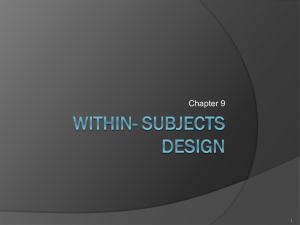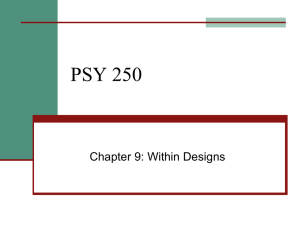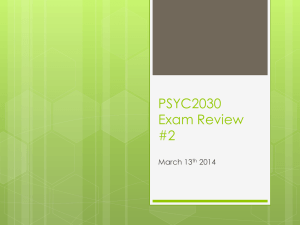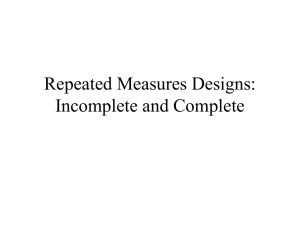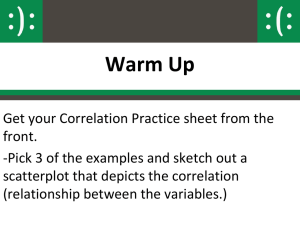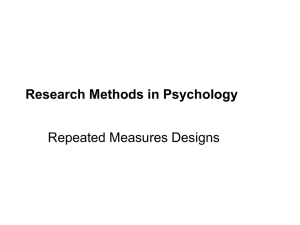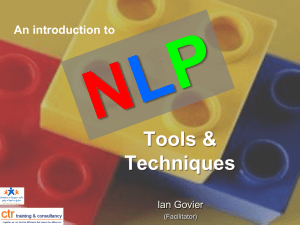statistical control technique
advertisement
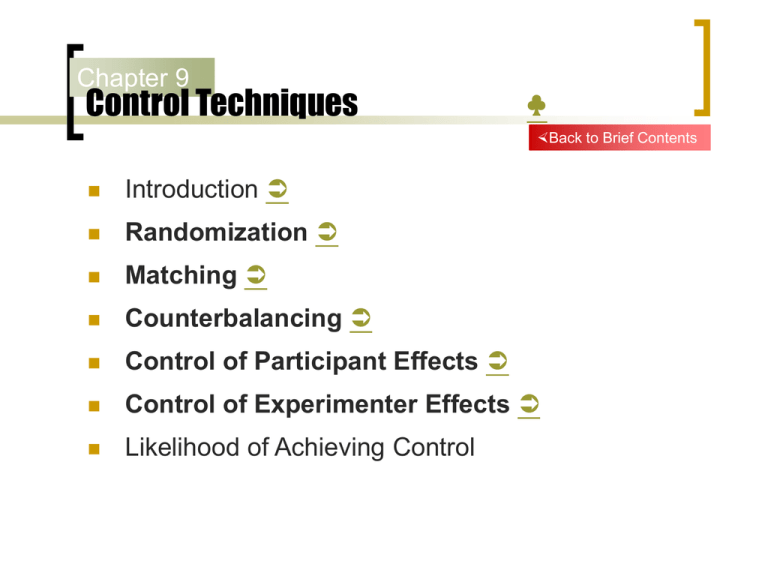
Chapter 9 Control Techniques ♣ Back to Brief Contents Introduction Randomization Matching Counterbalancing Control of Participant Effects Control of Experimenter Effects Likelihood of Achieving Control 9.0 Introduction Back to Chapter Contents Goal of experimentation ― identify the causal effect of the IV Must have internal validity to do this Internal validity requires control of confounding variables Ways of achieving control — Design of the experiment — Statistical adjustments — Incorporate control techniques into the research design 9.1 Randomization -1 Back to Chapter Contents Randomization is a statistical control technique to equate groups of participants This is the most important and basic control technique Random selection —selecting people at random from a defined population Insures that the sample selected is representative of the population representative: sample P have the same characteristics as the people in the population Studies seldom if ever do this because of expense, etc 9.1 Randomization -2 Back to Chapter Contents Random assignment —randomly assigning participants to treatment groups Provides maximum insurance that groups are equal Equates groups because every person has an equal chance of being assigned to each group Accomplishes this by randomly distributing the extraneous variables over the treatment groups Fig 9.1 Tab 9.1 9.1 Randomization -3(end) Back to Chapter Contents Random Assignment Exercise Randomly assign 40 children to four different drug conditions using the table of random numbers in appendix D Exhibit 8.1 1 2 Logon to www.randomizer.org and use the randomizer in this site to randomly assign 40 children to the four drug conditions 9.2 Matching -1 Back to Chapter Contents Uses of any of a variety of techniques to equate participants in the treatment groups on specific variables Advantages of matching Controls for the variables on which participants are matched Increases the sensitivity of the experiment 9.2 Matching -2(end) Back to Chapter Contents Matching by Holding Variables Constant Matching by Building the Extraneous Variable into the Research Design Matching by Yoked Control Matching by Equating Participants 9.2.1 Holding Variables Constant Back to Chapter Contents Matches on the variable held constant Fig 9.2 Disadvantages Restricts the population size Restricts generalization to the type of participants in the study 9.2 9.2.2 Building EV into Research Design Back to Chapter Contents Should be used only when you are interested in the effect of the effect of the extraneous variable Fig 9.3 9.2 9.2.3 Matching by Yoked Control Back to Chapter Contents Controls the temporal relationship between an event and a response Brady (1958) Emotional stress → Ulcer Stress: Press a lever every 20-sec to avoid shock Control: receive the same temporal sequence of shock 9.2 9.2.4 Matching by Equating Participants Back to Chapter Contents Precision control —match case by case Fig 9.4 Disadvantages Identifying the variables on which to match Matching increases as the number of variables on which to match increases Some variables difficult to match Frequency distribution control —match on the overall distribution of the selected variables Fig 9.5 Disadvantage Combination of variables may be mismatched (e.g.) Age-IQ: (E) Old-high IQ, Young-low IQ (C) Old-low IQ, Young-high IQ 9.2 9.3 Counterbalancing Back to Chapter Contents Used to control sequencing effects Type of Sequencing effects Fig 9.6 Order effect Tab 9.2 arising from the order in which the treatment conditions are administered to P Carry-over effect Tab 9.3 occurs when performance in one treatment condition affects performance in another treatment condition Counterbalancing procedures Intrasubject Counterbalancing: The ABBA technique Intragroup Counterbalancing 9.3 Counterbalancing - intrasubject Back to Chapter Contents Intrasubject or ABBA technique — counterbalances on a case-by-case basis Controls only for linear sequencing effects Tab 9.4 Nonlinear order effects can be controlled if you use the ABBA plus BAAB counterbalancing Tab 9.5 Can’t control nonlinear carry-over effects 9.3 ◄ 9.3 Counterbalancing – Intragroup -1 Back to Chapter Contents Intragroup Counterbalancing (e.g.) ABC ACB BAC BCA CAB CBA Incomplete Counterbalancing (Latin square) Participant 1 2 3 4 Sequence A B D C B C A D C D B A D A C B 9.3 ◄ 9.3 Counterbalancing - Intragroup -2 Back to Chapter Contents Intragroup Counterbalancing Incomplete Counterbalancing (Latin square) A B C D E B C D E A E A B C D C D E A B D E A B C D E A B C C E D A E B A C B D B C D E A A B C D E 9.3 ◄ 9.3 Counterbalancing - Intragroup -3(end) Back to Chapter Contents Intragroup Counterbalancing Incomplete Counterbalancing (Latin square) 1,2,n,3,(n-1),4,(n-2),5,… 2,3,n+1,4,… (e.g.) A B C D E F B F C E C A D F D B E A E C F B F D A C A E B D D E F A B C ( p. 282, 283 ) 9.3 ◄ 9.4 Control of Participant Effects -1 Back to Chapter Contents Double Blind Placebo Model Participants, Experimenter Blind: the treatment condition administered to P Deception ― giving the P a bogus rationale for the experiment provide hypothesis : unrelated or orthogonal; false but plausible 9.4 Control of Participant Effects -2(end) Back to Chapter Contents Perceptual Control, or Control of Participant Interpretation Retrospective verbal report postexperimental inquiry Concurrent verbal report sacrifice groups: stopped at a different point concurrent probing: at the end of each trial think-aloud technique 9.5 Control of Experimenter Effects -1 Back to Chapter Contents Control of Recording Errors Aware of the necessity: ensure the accuracy Kept blind Mechanical or electronic device Control of Experimenter Attribute Errors Interact with treatment effect? Minimize: Control Attributes that correlate with DV Tab 9.6 9.5 Control of Experimenter Effects -2(end) Back to Chapter Contents Control of Experimenter Expectancy Error The Blind Technique The Partial Blind Technique Automation
